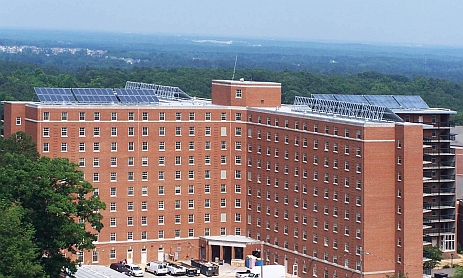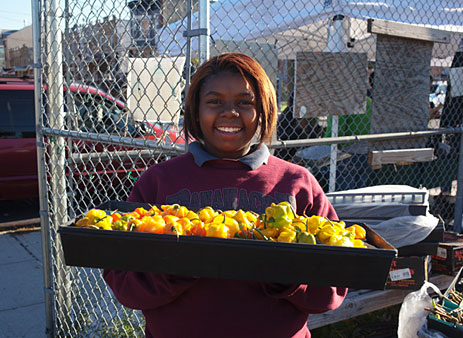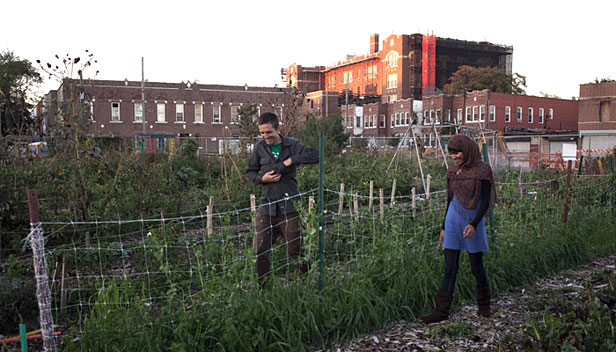 Good neighbors: East New York Farms! manager David and Afroza, an intern.Photos: Hugues Anhes
Good neighbors: East New York Farms! manager David and Afroza, an intern.Photos: Hugues Anhes
The Color of Food series is about my experiences searching for black and Latino farmers in the sustainable food movement.
I knew I was far from the apple orchards of West Virginia (where my farming journey began) when I found myself smack in the middle of the Big Apple, sitting on the subway between a man holding a live turtle in a five-gallon bucket and a man preaching the words of Ras Tafari to no one.
This, I thought, can only happen in New York City.
I don’t fit in either with all the suits and ties making their evening commute home; I sit on the train in dirt-caked jeans with carrot tops and basil hanging out of my backpack. In the city where anything goes, even I get some crazy looks. I just shrug and smile. It’s official now, I feel like a city farmer.
Eating their words
The first thing I discovered is that the food movement in New York is not only alive and kicking, but very well-connected. Everyone I met referred me to the leading food justice organization, Just Food, which is launching a Farm School this year to train aspiring urban farmers, educators, and food justice leaders. They also said I should meet Karen Washington, a Just Food board member and lifelong Bronx resident who’s been working in the movement for decades; she’s also the president of the New York City Community Garden Coalition.
I was lucky enough to hear Karen speak at a couple of the many events I’ve attended since arriving. One such gathering was the New School’s Living Concrete/Carrot City series, discussing design and planning for urban farms of the future, where I also met Dennis Darryck, who started a farmshare project for residents of the South Bronx and Harlem. Karen and Dennis talked about the importance of this work in low-income communities, and they stressed the goal of getting New York’s 1.4 million food-insecure residents off WIC, SNAP, and other government-funded food programs and into jobs and ways to own their food sources.
“There are only 50 black farmers in New York State,” said Karen. “We need to change that.”
I also attended the Harlem Harvest Festival and Food Summit, organized by Harlem4. I was completely inspired by the Food Justice panel discussion, which featured Asantewaa Harris from the Community Vision Council. CVC is heavily involved in saving black farmers and is organizing the very first Black Farmers and Urban Gardeners Conference here in Brooklyn, which will feature keynote speaker Will Allen from Growing Power, among others.
When I’m not farming or going to panel discussions, I’ve been checking out farmers markets and other farms. I have discovered some great farms and organizations, such as Tagwa Community Farm in the Bronx, run by Abu Talib (pictured in the New York Magazine article “What an Urban Farmer Looks Like” as the only person of color); the Brooklyn Rescue Mission, which has a farm in the Brooklyn neighborhood of Bed-Stuy; and La Finca del Sur, which is a small farm, led by women of color, between the highway, train tracks and the projects in the South Bronx.
After meeting so many inspirational activists and gardeners, I felt like I could hardly keep up. The presence and empowerment of blacks and Latinos in the urban farming movement in NYC seemed solid.
The second thing I have discovered, however, is that not everything is how it seems.
Value-added tactics
One of the urban farms I’d contacted before I arrived was the Red Hook Community Farm, run by Added-Value. Red Hook residents’ average income is below $15,000, and the area is home to a virulent heroin trade. I was excited to see a farm succeeding despite such adversities.
Added-Value’s website says its mission is to grow a “just food system” and empower youth, so I was a little surprised to walk onto the farm and see no signs of this. For the most part, the farm seemed to be a commercial operation catering to restaurants and a Community Supported Agriculture program and market serving a wealthier, white consumer base. (To be fair, I was not there in the evenings when most of their youth come in to work.)
In discussing this disparity with some of the farmers, it was apparent that Added-Value is aware of the problem. They even indicated that the transformation of their work was due to unintentionally attracting a certain consumer base — they are located right across from New York’s only Ikea — and thus excluding the community members they set out to work with. Their solution, as far as I could gather, was about expanding and breaking ground inside the housing projects around the corner.
I was bothered by this misrepresentation, though. It’s become clear to me that the lack of direct involvement by community members in some of these projects is the first problem with this movement.
Kamali Williams from Harlem4 seems to agree. “We have enough discussions about communities, but not enough community discussions,” she said at the Harlem Harvest Festival, explaining that this is why their organization exists.
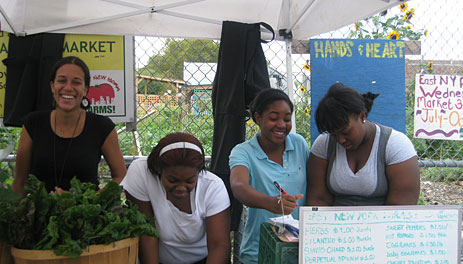 I had too much fun helping out at the farmers market with the ENYF! crew. East menders
I had too much fun helping out at the farmers market with the ENYF! crew. East menders
The second farm I’ve been working with, and spending the majority of my time on, grew entirely out of community discussions. East New York Farms! is located in East New York, a neighborhood of Brooklyn that was once notorious for its violent crime; over half of its population still lives under the poverty line and on public assistance programs.
East New York is also home to the most community gardens — 60! — in one neighborhood in all of New York City. Most of these, however, were being run by older residents; when community discussions were had, the need for a productive space for the neighborhood’s youth was clear. East New York Farms! was born.
The high school kids working on the farm stole my heart the very first day. They’re passionate about what they’re doing, and it shows.
“When I first heard of East New York Farms I thought it was going to be a farm outside of the city,” said Cameal, a 16-year-old intern at the farm. “I was surprised that you could grow food in the city, especially in east Brooklyn, because people think this area is bad. The things you witness with your own eyes, you’d never think this could happen here.”
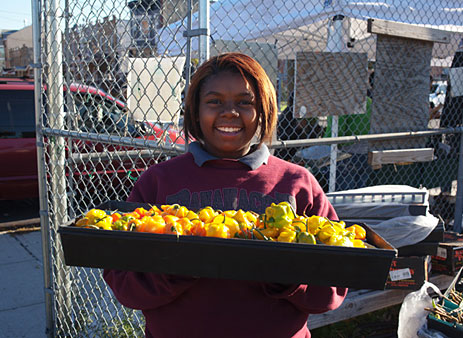 Pick a pack of peppers: Kalia shows off the harvest.“[The farm] for me is a place to express myself, to learn, get involved with the community and eat healthier,” said Afroza, another 16-year-old intern. “When I joined the program, I wouldn’t eat breakfast — I’d go to the corner store and eat a bunch of junk and then feel nauseous. But now I don’t go to the corner store anymore and eat that junk.”
Pick a pack of peppers: Kalia shows off the harvest.“[The farm] for me is a place to express myself, to learn, get involved with the community and eat healthier,” said Afroza, another 16-year-old intern. “When I joined the program, I wouldn’t eat breakfast — I’d go to the corner store and eat a bunch of junk and then feel nauseous. But now I don’t go to the corner store anymore and eat that junk.”
“I think we need a lot more organizations like ENYFarms because they are helping increase the fruit and vegetable consumption in the neighborhood,” said 14-year-old Kalia, “and we need more education on it and more kind people like the people here.”
All the people I have met working in this movement in New York have inspired me, but East New York has something special. I hope to find more of that something in the communities I venture to next.
More resources
Additional black and Latino leaders in the food movement that I’ve discovered in New York:
- Hattie Carthan Garden
- Weeksville African American Heritage Center
- Bronx to Barn
- Soul Fire Farm
- Malcolm X Grassroots Movement
- Mimomex Farm and La Union
- Milk not Jails
- Eat Grub, with eco-chef Bryant Terry
- Melissa Danielle
- Food Culturist
- Corbin Hill Farm
- Harlem Seeds
- Trinity Farm
- Phoenix Community Garden
- Garden of Happiness
